Chinese measures against COVID-19 impact logistics
Cargo flows at China’s largest ports continue to face disruption as a new wave of coronavirus infections across the country poses a threat to the global supply chain. Key port cities, including Shanghai and Ningbo, are facing logistics bottlenecks as China is grappling with its worst spate of infections. China is blocking more highways to curb the spread of coronavirus as the snarl-up in Reduced trucking capacity in Shanghai and the closure of factories and warehouses have caused some ocean freight to be diverted, with Ningbo, Qingdao, and Tianjin topping the list of alternative ports. The Chinese government has intervened to prevent reducing vessel calls at Shanghai as carriers have started to bypass the world’s largest container port affected by coronavirus lockdowns.
Risks surrounding the shipping industry
Shippers continue to face serious bumps in the road to recovery as unexpected events continue to batter the sector. While the direct impact of the Russian invasion of Ukraine on container shipping was limited, the war was still affecting supply chains. Downside risks are increasing, but congestion will continue to benefit box lines. Economic and geopolitical uncertainty risks lower demand. But any recovery of supply chains is unlikely before 2023. Uncertainty over the global economy, the war in Ukraine, and the pandemic’s development are unlikely to put any significant dent in carrier profitability, despite a growing “laundry list” of risks facing the sector. The strong likelihood of continued growth in the reefer trade creates questions about supply meeting demand given recent world events and the potential upstream production dependencies linked to raw material sourcing. Prolonged lockdowns in Shanghai, home to the world’s busiest container port, might help relieve congestion on the other side of the Pacific.
Carriers need to strike a balance between ‘greener’ and ‘bigger’
In a world where geopolitical uncertainty is rising, trading patterns are shifting, and incremental growth of shipping demand cannot be taken for granted, carriers need to balance between building greener ships and pursuing a larger fleet.
OSRA leaves key questions on ‘unreasonable’ export denials unanswered: analyst
Although the Ocean Shipping Reform Act of 2022 is now almost sure to become law, it’s not clear how the law’s provisions regarding fair rates, reasonable assessorial charges, and determination of best practices will be implemented when it goes into effect.
click here for more information about iran sea freight .
Inland container storage area project in California
California’s container ports will collaborate with importers, commodity exporters, and local development agencies in the Central Valley to establish four inland ports intended to speed the flow of containers to and from the seaports and reduce the cost of domestic transportation. The California Inland Port (CIP) project, a $30 billion, 400-mile trade corridor that will stretch from the ports of Los Angeles and Long Beach to Sacramento, is still in its nascent stage even though discussions have been underway for three years. The goal is to establish four major inland hubs and seven smaller satellite ports to relieve congestion at the seaports while increasing cargo velocity to and from the seaports. On the other hand, Gov. Gavin Newsom designated six properties (three in Southern California and three in Northern California) as temporary storage sites for loaded containers. California’s initiative is to give importers and exporters immediate access to locations within 60 miles of the ports for the temporary storage of containers that are now dwelling at the ports, aggravating congestion that has been present for the past 20 months amid record or near-record cargo volumes.
Panama Canal looks to implement tolls for empty containers
The Panama Canal Authority (ACP) is proposing a new tolling plan for container ships that would, for the first time, assess a fee on empty containers repositioning to Asia. The plan would also increase tolls for other types of ships carrying laden and empty containers. The proposed toll changes, approved by the canal’s board of directors, will now be reviewed by shipowners. If approved, they will go into effect in January 2023.
Methane leaks from LNG ships caught on infrared camera
Transport & Environment, an umbrella lobbying organization for environmental groups, said infrared footage of unburned methane from ships at Rotterdam port showed that ‘fossil gas has no role to play in the future of green shipping.’ The NGO used a special camera to show methane slip from liquefied natural gas-fuelled ships, including the vessel CMA CGM Louvre, with ‘alarming repercussions for the climate.’ A probe into ‘green’ liquid natural gas ships has uncovered ‘significant amounts of invisible methane’ being released into the atmosphere.
How Japan’s carbon levy and rebate scheme would work
Japan has proposed a global carbon levy scheme at the International Maritime Organization. The ‘feebate’ system of charges and rebates — which opens the door to carbon offsets — joins proposals by the Marshall Islands, Norway, and industry groups for debate by IMO states. The measure could be popular with industry for its simplicity, especially compared with Norway’s cap-and-trade scheme. But like other carbon curbs, it will face opposition from developing countries.
New fee to support zero-emission drayage fleet at LA-LB
The ports of Los Angeles and Long Beach began assessing $10 per TEU on shippers for laden containers into or out of the gateway by trucks. Most of the estimated $90 million to be collected in the first year will go toward trucker subsidies for purchasing zero-emission trucks. The goal of the new fee is to push up demand for plug-in and battery-electric trucks in support of a self-imposed mandate at the busiest US port complex to have a 100 percent zero-emission drayage fleet by 2035. An electric-powered truck costs about $350,000, approximately three times the price of a diesel truck. But port officials hope increased demand leads to mass production of zero-emission trucks and, in turn, a commercially viable price for those trucks.click here for more information about sea freight in iran .

